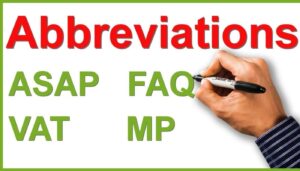When you’re working in education, abbreviations can be lifesavers. They help us save time, space, and effort, especially in environments like classrooms or busy offices where quick communication is essential.
If you’ve ever wondered, “What is the abbreviation for teacher?” or felt unsure when and how to use it, you’re in the right place. In this article, we’ll explore the most common abbreviation for teacher, why it’s used, and when it’s appropriate.
You’ll walk away with a clear understanding of this useful shorthand and how to use it confidently in your own work or communication.
Understanding the Abbreviation for Teacher
The most commonly used abbreviation for the word “teacher” is “Tchr.” It’s a convenient shorthand used in informal settings to save time and space while still conveying the meaning clearly.
The abbreviation is especially helpful when you’re dealing with large groups, such as in class rosters, schedules, or emails to colleagues. But while it’s a handy tool, it’s important to know when and where to use it to avoid confusion.
Why Use an Abbreviation for Teacher?
Abbreviations like “Tchr.” are widely used in educational settings for several reasons:
- Efficiency: When you’re filling out class rosters or schedules, using abbreviations saves space and time, which is vital when you have a lot of information to manage.
- Informality: In internal communication (like between staff or within a school district), abbreviations can create a sense of familiarity and ease.
- Clarity: In environments where speed matters, such as in quick notes or reminders, using abbreviations helps streamline communication without sacrificing understanding.
While abbreviations can be extremely practical, they’re best used in the right contexts, as we’ll discuss in a bit.
Common Abbreviations for Teacher

Let’s start by diving deeper into the abbreviations for teacher that are most commonly used.
- Tchr.
- This is the most widely recognized and used abbreviation for “teacher.” It’s perfect for quick notes, schedules, or class assignments, where space is limited, and formal language isn’t needed.
- Example: “Tchr. Smith will be overseeing the project for this term.”
- Prof.
- Short for “Professor,” this abbreviation is used primarily in higher education. It’s a more formal abbreviation than “Tchr.” and is often used to refer to university instructors.
- Example: “Prof. Johnson is hosting the lecture on Monday.”
- Instr.
- This abbreviation, short for “Instructor,” can be used similarly to “Tchr.” but is more common in formal or specialized settings, especially when referring to people teaching specific subjects or skills.
- Example: “Instr. Lee will lead the art workshop this semester.”
The Role of Teachers: Why the Abbreviation Matters
Before we dive into specifics about when to use the abbreviation, let’s quickly revisit what “teacher” means. At its core, a teacher is someone who imparts knowledge, skills, and guidance to students.
The role can be formal, such as a classroom instructor in primary or secondary education, or more informal, such as a mentor or tutor helping someone grow personally or professionally.
In the classroom, teachers are responsible for guiding students through their learning journeys, helping them grasp new concepts, and supporting their intellectual and personal development. This can include creating lesson plans, managing classrooms, or even offering individual mentorship.
By understanding the significance of the role, you’ll also better understand why abbreviations like “Tchr.” matter. They allow for a more efficient means of communication in the fast-paced world of education while still honoring the teacher’s impact.
Pronunciation of “Teacher” and Its Abbreviation
It’s always good to understand how a word or abbreviation sounds, especially if you’ll be using it in speech. “Teacher” is pronounced as /ˈtiːtʃər/ (TEE-chur). It’s a straightforward word, but when abbreviated as “Tchr.,” it’s still pronounced the same.
Most people reading “Tchr.” will automatically recognize the word without confusion, as it’s closely related to the full term.
When to Use the Abbreviation for Teacher
While “Tchr.” is helpful, there are definitely contexts where you should use the full word “teacher” instead. Below, we break down when to use the abbreviation and when to avoid it.
Use “Tchr.” in Informal Settings
In informal settings, such as internal communications between staff members, class rosters, and scheduling documents, using “Tchr.” is perfectly acceptable. Here are some examples:
- Class Schedules: If you’re creating a printed or digital class schedule, abbreviating “teacher” as “Tchr.” is a quick and effective way to fit the information in tight spaces.
- Example: “Tchr. Williams will teach 9th Grade English this semester.”
- Emails: When sending a quick email to a colleague about classroom assignments or schedules, abbreviating “teacher” can help streamline communication.
- Example: “Can you confirm if Tchr. Thompson is available for the next meeting?”
- Internal Notes: When jotting down quick reminders or making class lists, using the abbreviation is useful for staying organized.
- Example: “Tchr. Evans, please meet in the staff lounge after school.”
Avoid Using “Tchr.” in Formal Documents
While abbreviations are fantastic for informal communication, they don’t always translate well into formal documents.
In formal reports, official evaluations, or any communication where clarity and professionalism are key, it’s better to spell out “teacher.” Some examples include:
- Performance Reviews: In teacher performance evaluations or detailed reports, it’s important to maintain a professional tone, so spelling out “teacher” is preferred.
- Example: “Ms. Johnson, the teacher, has demonstrated excellent skills in classroom management.”
- Official Correspondence: When communicating with parents, school boards, or in any official capacity, the word “teacher” should be used in full to avoid confusion or the appearance of being too casual.
- Example: “The teacher will meet with parents to discuss the student’s progress.”
Abbreviations for Other Roles in Education
In addition to abbreviating “teacher,” there are many other common roles in education that also have abbreviations. These include:

- TA – Teaching Assistant
- TAs assist teachers in the classroom and often take on responsibilities such as helping with assignments, grading, or assisting students with questions.
- Example: “TA Garcia will help manage the group project.”
- HOD – Head of Department
- The HOD is responsible for overseeing a specific department in a school (e.g., the science or history department).
- Example: “HOD Green will present the new curriculum to the staff.”
- PE – Physical Education
- This abbreviation refers to physical education classes or instructors who teach subjects related to sports and fitness.
- Example: “PE class will meet in the gym for today’s session.”
Synonyms for Teacher
In different contexts, you might prefer to use synonyms for “teacher” rather than the standard term. Here are a few alternatives:
- Instructor: Often used in more formal or specialized contexts, such as sports, arts, or higher education.
- Educator: A broad term that refers to anyone who teaches, whether formally or informally.
- Mentor: A teacher-like figure who provides guidance and support, especially outside the traditional classroom.
- Coach: A teacher in the realm of sports, but increasingly used to refer to someone who helps others develop personal skills.
- Guide: Someone who provides direction and support, often used in collaborative or student-led learning environments.
Final Words
In summary, the abbreviation “Tchr.” is a valuable shorthand for teachers, helping to streamline communication in informal and internal contexts. However, it’s important to use it appropriately.
In casual settings like schedules and emails, it’s a great time-saver, but for formal documents or professional correspondence, spelling out “teacher” will ensure clarity and maintain a professional tone. By understanding the nuances of when and how to use “Tchr.” and other teacher-related abbreviations.
you can communicate more efficiently in the educational environment while respecting the importance of the teacher’s role. Whether you’re an educator, administrator, or simply someone interested in education, mastering these simple abbreviations can make your work a little easier and more organized.









